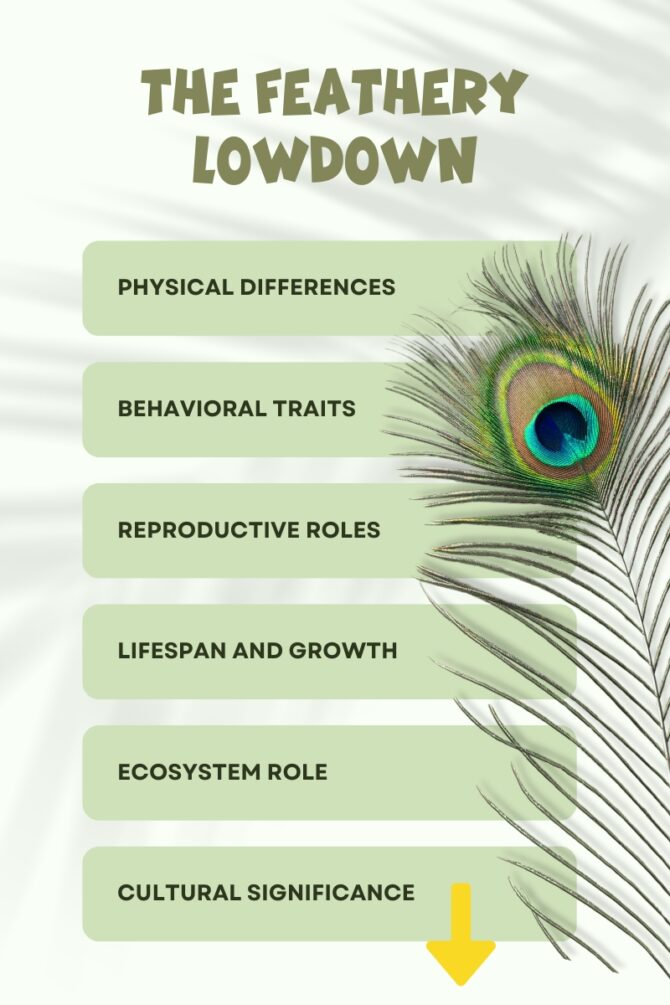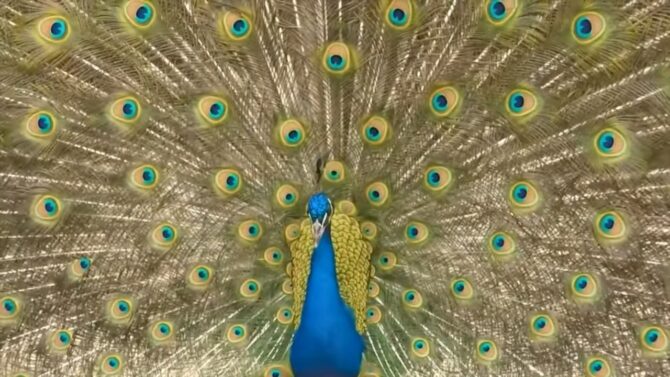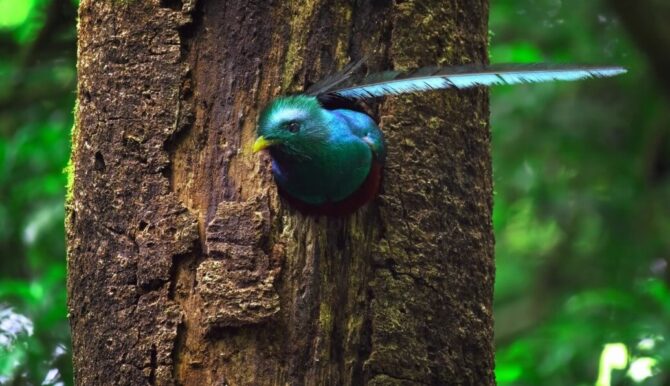The world of birds offers a spectacle of colors, sounds, and behaviors. Among them, peacocks are perhaps one of the most distinguished and easily recognized due to their opulent tail feathers and vibrant colors.
While commonly referred to as “peacocks,” it’s crucial to note that only males are called “peacocks” while females are termed “peahens.” Together, they fall under the umbrella of “peafowls.”
The Feathery Lowdown:

| Attribute | Male (Peacock) | Female (Peahen) |
|---|---|---|
| Physical Differences | ||
| Size and Stature | 90 to 130 cm long (bill to tail) + up to 150 cm for train | 86 to 100 cm in length (no extended train) |
| Plumage | Vibrant and multi-colored with iridescent blue and green. Train decorated with “ocelli” (eye-like spots). | Subdued colors: brown, green, and grey. Helps in blending into surroundings. |
| Head and Neck | Shimmering blue with patches of white | Greenish hue with a brownish or cream-colored crown |
| Behavioral Traits | ||
| Display Behavior | Courtship dance involving fanning out the train and quivering feathers. | Observers; watch multiple displays before selecting a mate based on the most impressive display |
| Vocalizations | Loud calls that establish territory and used during courtship displays | More subdued calls for communication and alerting to danger |
| Aggression | Aggressive during breeding season, defending territories | Less aggressive, but will defend chicks if threatened |
| Reproductive Roles | ||
| Nesting | No role in nesting. | Selects hidden spots for laying eggs, incubates eggs, and cares for chicks |
| Mating | Can mate with several peahens during the breeding season | Lays a clutch of eggs (usually 3-5) after selecting a mate and incubates them |
| Lifespan and Growth | Sexual maturity around 2-3 years. Train grows till 4-5 years. Lifespan: ~20 years in the wild | Maturity often by 2 years. Lifespan similar to males, averaging around 15-20 years |
| Ecosystem Role | Both male and female control pests by feeding on various insects and contribute to seed dispersal. | Both male and female control pests by feeding on various insects and contribute to seed dispersal. |
| Cultural Significance | Predominantly the male, with its impressive plumage, symbolizes beauty, grace, and immortality across cultures. In Hinduism, associated with Lord Krishna (divine love). | While the female doesn’t carry the same cultural significance as the male, her role in reproduction and nurturing ensures the continuity and cultural relevance of the species as a whole. |
Peafowls have been a subject of human fascination for centuries, and not just for their radiant plumage. Beyond the eye-catching beauty and striking differences between the sexes, there are numerous lesser-known facts about these birds that can spark wonder. Let’s dive into some delightful tidbits about both male and female peafowls.
Male Peacock (Peacock)

Dazzling Display: It’s not just the size of the peacock’s train that impresses the ladies but also the number of eye spots. Studies suggest that peahens may prefer males with a larger number of these ocelli.
Color Illusion: While their feathers seem to shimmer with vibrant blues and greens, peacock feathers are actually brown. The colors are a result of the way light refracts off microscopic structures in the feathers.
Unique Sound: When a peacock fans its feathers during the courtship dance, it produces a low-frequency sound that’s inaudible to human ears. This sound, called “infrasound,” can travel long distances and is another tool to woo potential mates.
Vanity Fair: Legend has it that peacocks are vain creatures. Ancient stories tell of peacocks catching their reflection in water and spending hours gazing at themselves.
Dance Stamina: A single male peacock can display his feathers and perform his courtship dance dozens of times in one day during the peak of the mating season.
Female Peacock (Peahen)

Selective Sight: Peahens have a unique way of evaluating potential mates. Recent research suggests they focus on the lower part of the males’ trains during displays, concentrating on the size and quantity of the ocelli.
Mother’s Instinct: When in danger, a mother peahen will feign injury, limping or dragging a wing, to draw predators away from her chicks – a classic example of a “distraction display.”
Subtle Beauty: Though often overshadowed by the peacock’s flashy plumage, peahens have their own understated beauty. Their muted colors are punctuated with green and blue, especially on the neck, providing a delicate contrast.
Independent Ladies: While male peacocks rely on their displays to attract a mate, peahens play a more proactive role in mate selection. They are known to walk away from a displaying peacock if they’re not interested.
Stealth Mode: The peahen’s muted colors serve a practical purpose. Beyond camouflage, their plumage allows them to stealthily move around especially when they need to protect their nests from potential threats.
World Travelers: While native to South Asia and parts of Africa, human fascination with peacocks has led to them being introduced in places all over the world, from North America to Australia.
Ancient Connections: Peafowls have been revered and kept by humans for over 4,000 years. From palaces in ancient India to Roman gardens, their allure is timeless.
Royal Status: In many cultures, peafowls were considered birds of royalty and were often kept in the royal palaces. Their presence was seen as a sign of opulence and power.
Tasty Treat: Surprisingly, in certain cultures and eras, peafowls were not just ornamental birds. They were also a delicacy and featured in feasts of the elite.
Moult Marvel: Both male and female peafowls shed (molt) their feathers annually. This means the magnificent train of the peacock is grown afresh each year!
FAQs
Why do males have such vibrant plumage compared to females?
Male peacocks, or peacocks, have evolved their vibrant plumage as a form of sexual selection. The colorful, eye-catching feathers and their display play a pivotal role during courtship rituals. Peahens, on the other hand, have more muted colors to blend into their surroundings, providing camouflage especially when they’re nesting or protecting their chicks.
How do peahens choose their mates, given the numerous displays they witness?
Peahens are discerning when selecting a mate. Research suggests they focus on specific parts of the male’s train, like the size and quantity of the eye spots or “ocelli”. A more elaborate and vibrant display often indicates a healthier and more genetically fit male, which influences the peahen’s choice.
Do these birds keep their radiant train feathers throughout their lives?
No, peacocks shed or molt their feathers annually. This means the magnificent train is grown afresh each year. The train continues to grow in length and splendor as they age, reaching its peak around 4-5 years.
How do peahens protect their nests and chicks from predators?
Peahens exhibit a behavior known as the “distraction display” when they sense danger near their nests. They feign injury, like limping or dragging a wing, to lure predators away from the nest, sacrificing themselves if need be to protect their offspring.
Are the vocalizations of male and female peafowls different?
Yes, while both use calls for communication and to establish territory, the peacock’s calls are particularly loud and can carry over long distances. These calls are essential during courtship displays. On the other hand, the peahen’s call is more subdued but serves vital purposes such as alerting others to danger or communicating with potential mates.
Do male peacocks play any role in the nurturing of their offspring?
No, after the courtship and mating, the male peacock’s role essentially ends. It’s the peahen who selects a secure spot to lay her eggs and takes sole responsibility for incubating the eggs and caring for the chicks once they hatch.
Conclusion
The distinction between male and female peafowls goes beyond the obvious visual disparities. Their behavior, reproductive roles, and even cultural significance differ greatly. While the resplendent male peacock often captures our attention with his dazzling display, the subdued yet equally essential peahen plays a vital role in the continuation of the species.
Their harmonious coexistence not only contributes to the balance of their ecosystem but also serves as a reminder of nature’s intricate designs and the beauty it bestows upon the world.






